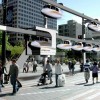Public Transit Gets a Major Magnetic Facelift in Abu Dhabi
Abu Dhabi, the capital of the United Arab Emirates (UAE), is no stranger to innovation and technology. The city boasts one of the world’s strongest economies and numerous modern amenities including numerous man-made islands.
One of these is Yas Island, a 25km2 tract of land in the Persian Gulf. Yas Island was constructed to serve as a tourist destination. Construction of the island began in 2006 and won’t conclude until 2018. However, the island already boasts numerous attractions such as the Yas Island Marina, a Grand Prix racetrack, and Ferrari World Abu Dhabi—a theme park devoted to the Italian luxury car.
One of the newest innovations on Yas Island and Abu Dhabi addresses transportation. For a city constantly on the cutting edge of technology, it makes perfect sense that it completely revolutionizes the way people get around.
Miral, the company that owns Yas Island, is partnering with skyTran, headquartered at the NASA Research Park in California, to construct a state-of-the-art transit system powered by magnets. These Personal Rapid Transits (PRTs) will be “two-person ‘jet-like’ vehicles employ[ing] a magnetic levitation technology instead of wheels” (skyTran) and will run on tracks above pre-existing roads and walkways. While plans exist for skyTran to connect Yas Island’s major attractions, there are already talks to expand the system to link Yas Island to the rest of Abu Dhabi and beyond.
Miral and skyTran officials both point to the numerous benefits of the PRT. Here are just a few from skyTran’s site:
- Energy Efficient - The transit system will use skyTran Magnetic Levitation (STML) which relies on magnetic forces to propel the jets rather than more conventional methods such as fuel.
- Eco-Friendly - Because of its magnetic propulsion system, skyTran is not dependent on traditional fuel sources and uses very little electricity per jet. According to skyTran, “the power used in two hair dryers can fly you at over 62 mph.”
- On-Demand - Unlike traditional mass transit that run on fixed time tables, skyTran’s system allows riders to select their destination and departure time from their computer or smartphone as well as at which station they’d like to be picked up.
- Low Impact - Unlike city buses that can clog major thoroughfares, subway systems that require high-maintenance tracks and massive stations, or even freeways themselves, a skyTran system only needs the occasional support pole to link its tracks. These can be installed along roads and sidewalks just like telephone poles. The support structures are made of lightweight aluminum and even have the potential to run through buildings—allowing commuters near door-to-door access to their destinations.

